New to sourdough bread? Here’s an easy Sourdough Bread recipe with thousands of success stories! Includes easy step-by-step instructions, videos, expert tips, and everything you need to master sourdough bread baking!
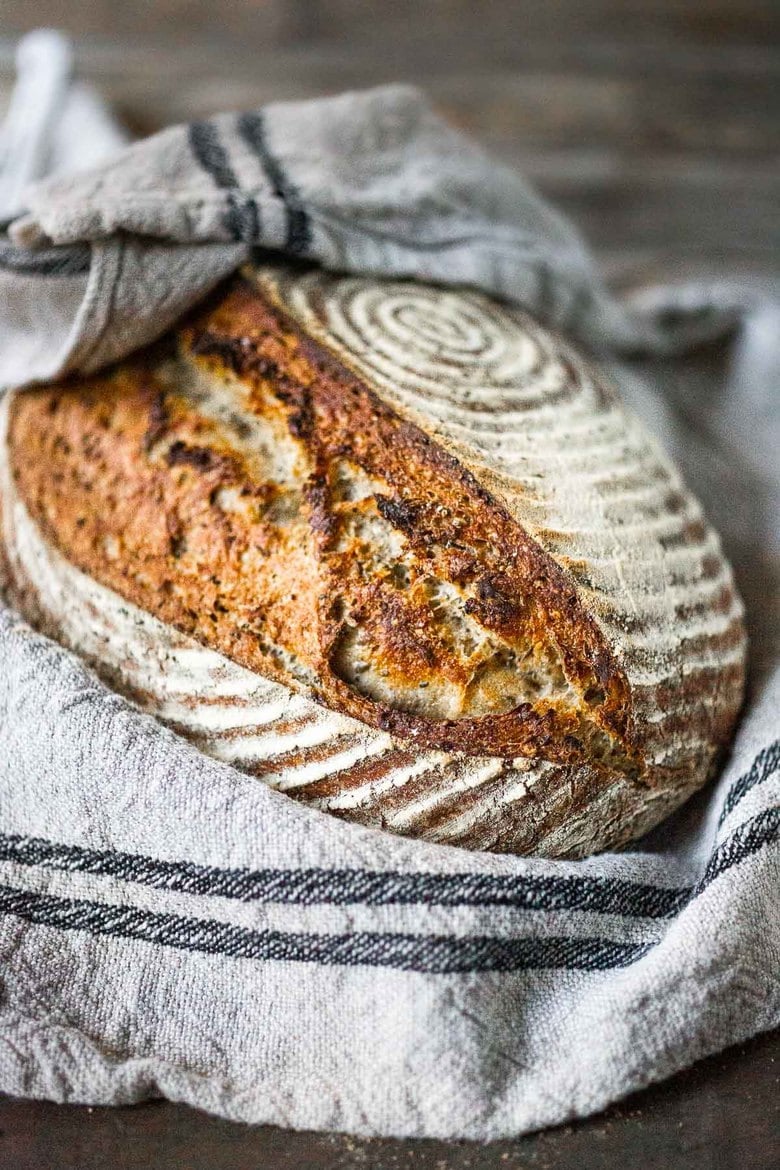
Are we free enough to open to the flow, no matter what it may contain?
Dorothy Hunt
This beginner’s guide to Sourdough Bread couldn’t be any easier. We’ve paired this sourdough recipe down to the simplest of techniques, showing you the basics while ensuring your first loaf of sourdough bread turns out amazing. Just read all our reviews! Once you understand the process, you can use it as a launching pad for your own creative sourdough journey.
Table of Contents
- But First, What is Sourdough?
- Why you’ll love Sourdough!
- Ingredients in Sourdough Bread
- Baking Tools
- Sourdough Starter Tips
- Baking Schedule
- Sourdough Bread Instructions (Step-by-step)
- Stretch & Fold Video (Technique #1)
- Stretch & Shape Video (Technique #2)
- Sylvia’s Expert Tips
- Trouble Shooting Sourdough Bread
- Sourdough FAQS
- Practice Makes Perfect!
- More sourdough recipes you’ll love!
- Sourdough BreaD Video (start-to-finish)
- Sourdough Bread Recipe
But First, What is Sourdough?
Sourdough bread is made through a natural leavening process and does not rely on commercial yeast for rising. Instead, it harnesses the power of a “starter,” a mixture of flour and water that is fermented- home to wild yeast and beneficial bacteria, which work harmoniously to rise the dough. The fermentation process not only helps the dough rise but also imparts a delightful tangy flavor and a slightly chewy texture characteristic of sourdough bread. Because sourdough is fermented and contains no preservatives or additives, sourdough bread is easier to digest than store-bought yeasted bread-so much healthier!
I started my own sourdough journey over 12 years ago, when my lovely friend Bee (from H is for Love) showed me how easy it could be – and this simple process hasn’t failed me yet, all the while bringing so much joy over the years. This is my hope for you!
Why you’ll love Sourdough!
- Easy Schedule: Make the dough the night before, proof it overnight on the counter (10-12 hours), and bake it in the morning. (Alternatively, the dough can be made in the morning and baked at night). It’s very flexible and can be placed in the fridge if something comes up, and you can’t bake in the morning, slowing the process down.
- Our Simplified Process: We’ve removed all the fussy, complicated processes that intimidate beginners from even starting. It is simplified down as much as possible while still producing a beautiful loaf! This sourdough bread requires no kneading and no fussing- it couldn’t be any easier to make with several basic techniques that anyone can do- see all 3 videos!
- It’s healthier than regular bread– sourdough contains no additives, preservatives or commercial yeast, and because it undergoes a fermentation process- it is easier to digest. Using organic flour ensures your bread is free of harmful herbicides often sprayed on wheat.
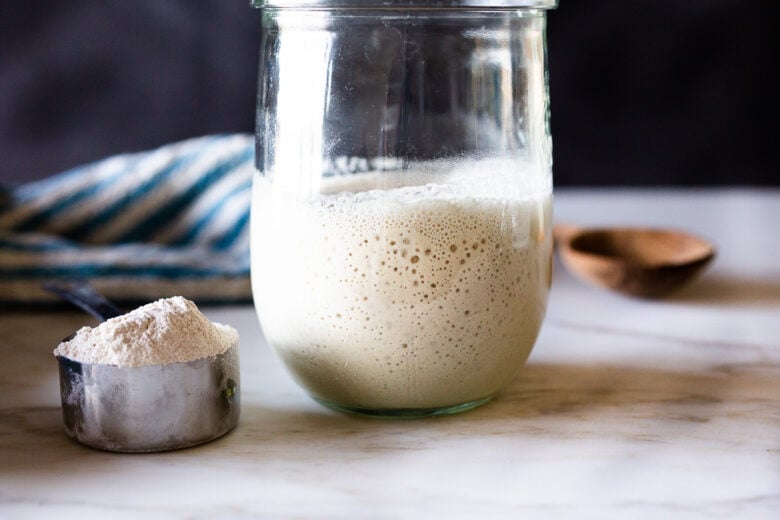
Ingredients in Sourdough Bread
- Sourdough starter – You can make sourdough starter at home (it takes 5-8 days) or purchase it here. To maintain it, store it in a jar in the fridge and feed it, like a pet. 🙂 Yes, you can even name it. If properly fed and cared for it can live for hundreds of years! My starter is called Vita.
- Bread flour – try to use organic bread flour, if possible. All-purpose flour works in a pinch, but bread flour produces a better loaf.
- Water– use tap water, filtered water, or mineral water. Distilled water lacks minerals so don’t use that.
- Salt– fine sea salt or Himalayan pink salt
- Optional extras: rye flour, fennel seeds, caraway seeds, chia seeds, rice flour
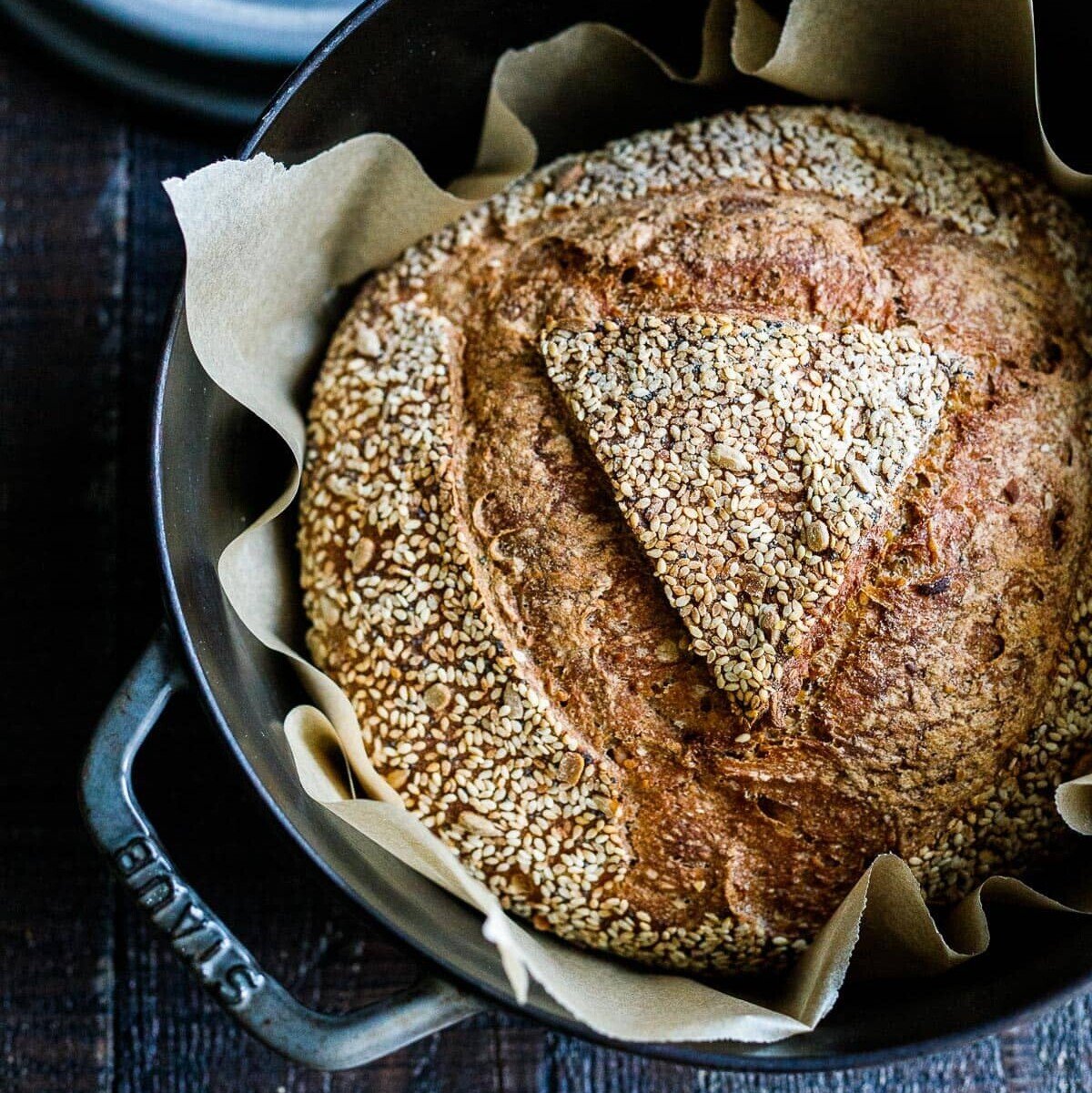
Baking Tools
After leaving all my favorite bread “gear” at home, it was a fun challenge to see if I could make bread with just the basics. Here is what you absolutely need:
- A Dutch Oven – I use and love this 5.5 Quart Staub Dutch Oven because of its metal knob and dark interior (it’s easy to keep clean). But something as simple and inexpensive as this cast iron dutch oven will work. Here are my favorite Dutch Oven picks for Bread baking! 4 ½ quart to 6-quart dutch ovens work well.
- High-Temp Parchment Paper- this “If You Care” Parchment Paper does not burn!
- A large bowl- glass or ceramic mixing bowl
- Measuring cups
- Kitchen towel
- Sharp knife, razor blade or scissors
- kitchen scale
- Thermometer
Here are some optional extras that make this more fun:
- Rice flour (for dusting)
- dough whisk
- Banneton (proofing basket) 9-10 round
- dough scraper
- Lame (scoring blade)
- Oven thermometer (to double check your oven is calibrated)
We offer this Sourdough-Making Kit at our Bowl and Pitcher Shop if you are interested.
Sourdough Starter Tips
- Be sure your sourdough starter is active and happy! It should double in size within 6-8 hours of feeding. If it is not doubling isn size, it will not rise your bread. For sourdough starter troubleshooting, please visit our sourdough starter post.
- When making sourdough bread, use a starter either right at it’s peak, or after it has peaked.
- For a more “sour” taste, use a starter that is “hungry”, and hasn’t been recently been fed.
Baking Schedule
Keep in mind that rising time is affected by weather and seasons. In winter, cold kitchens will lengthen the rising time. In summer or warm weather, hot kitchens will shorten the rising time. So this is a rough estimate based on 70F weather
- Morning (6 am to 10 am) Feed the sourdough starter. 8-12 hours before you plan to mix up the dough, feed your starter, allowing time to peak before using. (Or feel free to use an unfed starter for a more “sour taste”, straight from the fridge at 8 pm)
- Night (8 pm- 10 pm) Mix the dough. Do two sets of stretch and folds, 15 mins apart (see 1st video)
- Proof Overnight. Cover the dough, let it proof (rise) overnight 8-14 hours at 65-70F on the kitchen counter.
- Next Morning (6 am-10 am) Shape and Bake. Check your dough when you awake, and when it has almost doubled in size, stretch, fold, and shape. ( Watch 2ndVideo ). Place in a parchment-lined bowl seam side down. Place this in the fridge for 1 hour while you preheat the oven.
- Bake 20-25 minutes (or until internal temp reaches 200F). Remove lid, and bake 10-15 more minutes, until very deeply golden and internal temp reaches 208F. Let it cool on a rack before cutting.
Sourdough Bread Instructions (Step-by-step)
***Scroll down to the recipe card for concise measurements & instructions.
Step one: Feed the starter in the AM.
Feed your sourdough starter in the morning 8-12 hours before making your bread dough -leaving it out on the counter and using it slightly after it peaks. Always use a slightly “hungry” starter. TIP: You know your starter is active and healthy if it doubles within 6 hours of feeding. In the evening, make the dough, after the starter has peaked.
Step Two: Weight the flour.
In a large bowl, weigh bread flour (520 grams) using a kitchen scale- being careful not to include the bowl’s weight. Here I’m using roughly 4 cups of flour, spooned and leveled. (3 1/2 cups of organic white bread flour plus a 1/2 cup rye flour.)
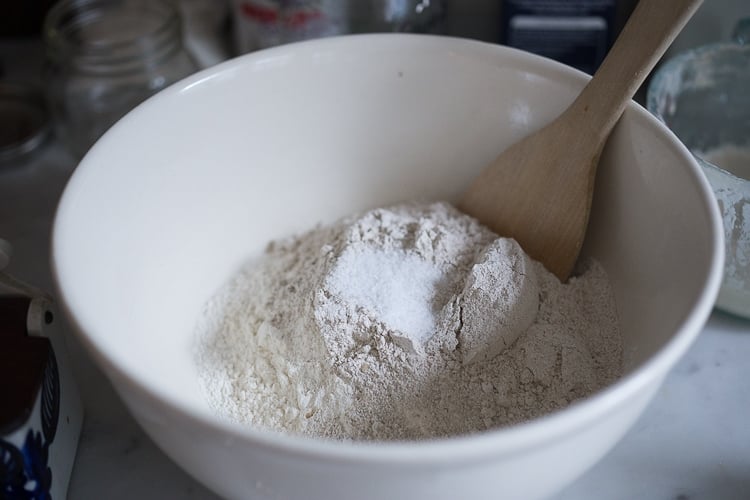
THEN Add 2 teaspoons salt and seeds if you like- here I’ve added 1 tsp fennel seeds, 1/2 teaspoon caraway and 1 tablespoon chia seeds.- I love this combination. Yes, you can add other spices and seeds. Get creative, but for the first loaf, I suggest going easy.
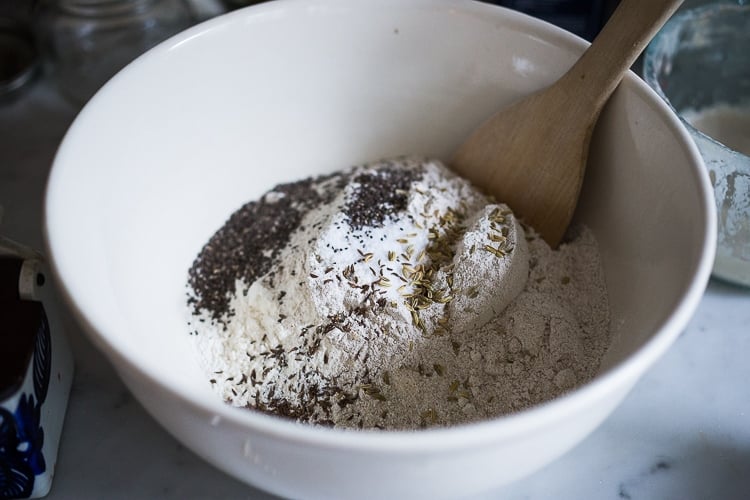
Step three: Mix the starter with water.
Stir down the starter, then mix 1/3 cup of sourdough starter (90 grams) with 1 3/4 cups water (385 grams) using a fork.
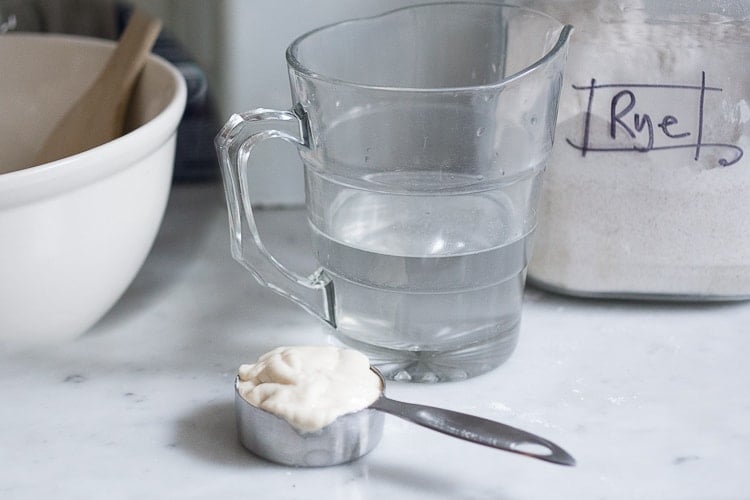
It will look like cloudy water.
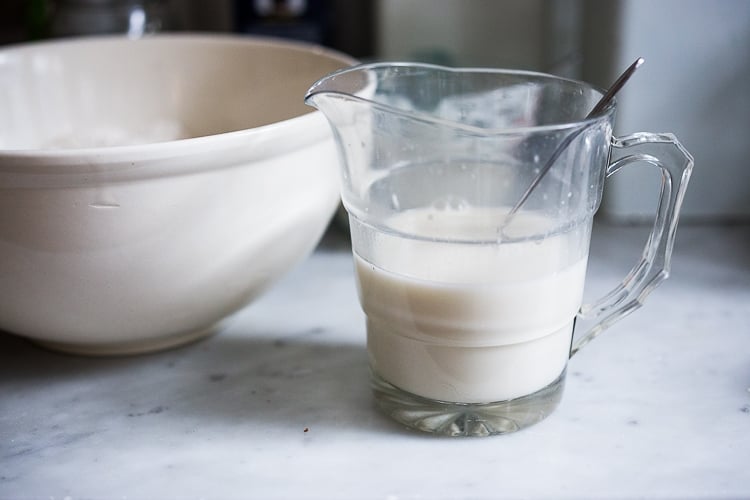
Step four: Mix The Dough (wet and dry).
Pour the starter/water mixture into the flour mixture and stir, using a fork, into a thick, sticky ball. Switch to a wooden spoon. Mix the dough for one minute to incorporate all the bread flour, using the wooden spoon. Just try your best to incorporate all the flour.
It will be thick, shaggy, and hard to mix. If the flour absolutely won’t mix in, then add a tablespoon of water at a time to incorporate it. Sometimes whole grain flour is “thirstier” than white flour, so you may need a little more water, a tablespoon at a time.
The dough will be heavy, thick and sticky (see photo below) to begin with, but will loosen up as it rests. Cover with a damp kitchen towel for 15 minutes, letting the dough rest.
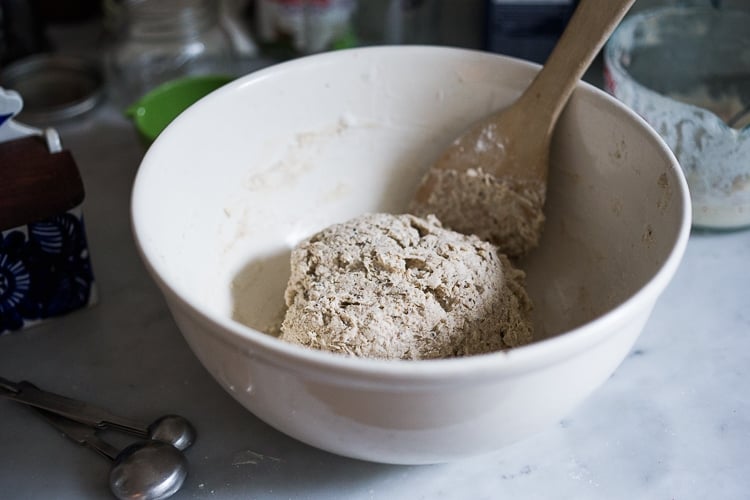
Step five: STRECH & Fold (video)
Do two “stretch and folds” sets to help build the gluten. Do this twice, 15 minutes apart. Watch the first video below. With wet hands, stretch and fold. Let dough rest 15 minutes covered, then repeat.
Stretch & Fold Video (Technique #1)
Don’t see the video? Allow 15-20 seconds to load it right here. If still not showing, check that your ad blocker is off, refresh the page, or try a different browser.
STEP SIX: PROOF THE DOUGH overnight
Cover the bowl with a damp kitchen towel (wet it thoroughly, then wring it out) and let the dough rise on the kitchen counter overnight 8-12 hours, at room temperature. This is called the bulk fermentation. Every environment is different, and seasons will affect the rising time. Warmer homes proof much faster, colder homes, much slower. In midwinter in the Northwest, I’ve even proofed for as long as 18 hours on the counter. Here in Santa Barbara, in summer, the dough was ready in 8 hours.
TIP: You can’t always look at the clock; you MUST look at the dough. It should be slightly domed, springy, slightly jiggly like a happy, full belly, almost doubled. Shake the bowl look for a bit of jiggle.
Do the poke test: Carefully poke the dough with a floured finger, 1/2 inch deep. If it is easy to indent, and the dough springs back, this is a good sign it has risen enough. If the dough feels very firm and hard to indent, it probably needs to proof longer. If the dough doesn’t spring back, holding the indentation, or feels overly soft, liquidy or loose- it is probably over-proofed. Don’t toss it. You can still bake it but will not rise as much in the oven and will be harder to handle. Put it in the fridge to firm it up a bit before doing the stretch and fold. You may still get an OK loaf. Hard to tell.
PREPARE the SHAPING BOWl: Place a piece of parchment in a bowl. I like using a high-sided medium-sized bowl versus a flat or shallow bowl, to help shore up the sides.
NOTE on Parchment: I use this parchment brand. It doesn’t stick or burn. If unsure about yours, spray your parchment with a little oil to prevent sticking.
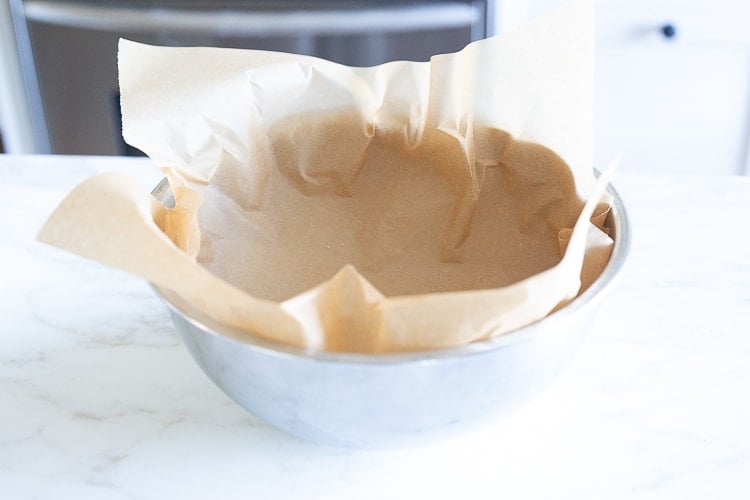
As you progress in your baking journey, you may want to use a Banneton (bread-proofing basket below). If using a Banneton, flour it well (rice flour works best here) and place any seeds on the bottom, placing dough seam-side up.
I will say- if starting out, it can be a bit tricky to flip the Banneton into the hot dutch oven, and have it land centered. I prefer to flip it onto parchment, score, then place the parchment and dough into the hot dutch oven. Up to you.
With using a piece of parchment paper in a regular bowl, there is no flipping, just lifting by the parchment and placing it in the dutch oven. Much easier!
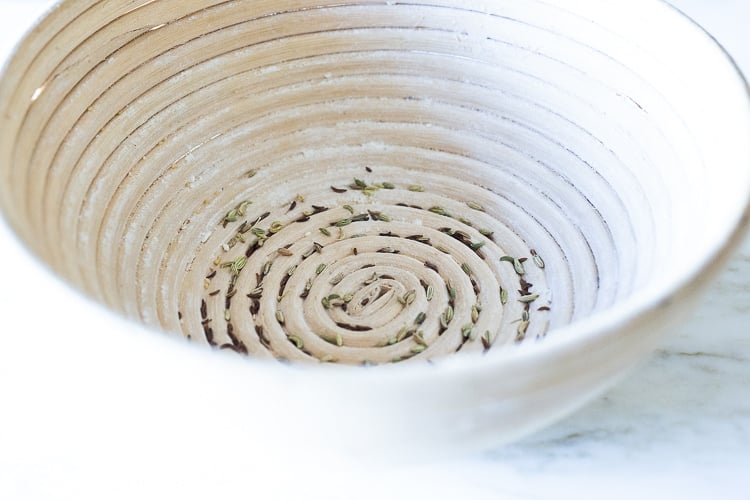
STEP 7: STRETCH and SHAPE (Video).
Watch the 2nd video below for a different “stretch and shape” technique to use AFTER the dough has been proofed. Loosen the dough from the edges of a bowl with a wet spatula or wet plastic dough scraper, sliding it down the sides of the bowl.
With wet hands, carefully pull the dough up on each side, lift it up about 1-2 feet high, and place it back down, folding it on top of itself gently.
Wet your hands again and give the bowl a quarter turn and do this again. (You could repeat this 20 minutes later) Then the 3rd time you lift and stretch, you will either lift it all the way up into your parchment-lined bowl seam side down. (EASIEST) or into the floured proofing basket, seam side up (pinching it closed).
Stretch & Shape Video (Technique #2)
Don’t see the video? Allow 15-20 seconds to load it right here. If still not showing, check that your ad blocker is off, refresh the page, or try a different browser.
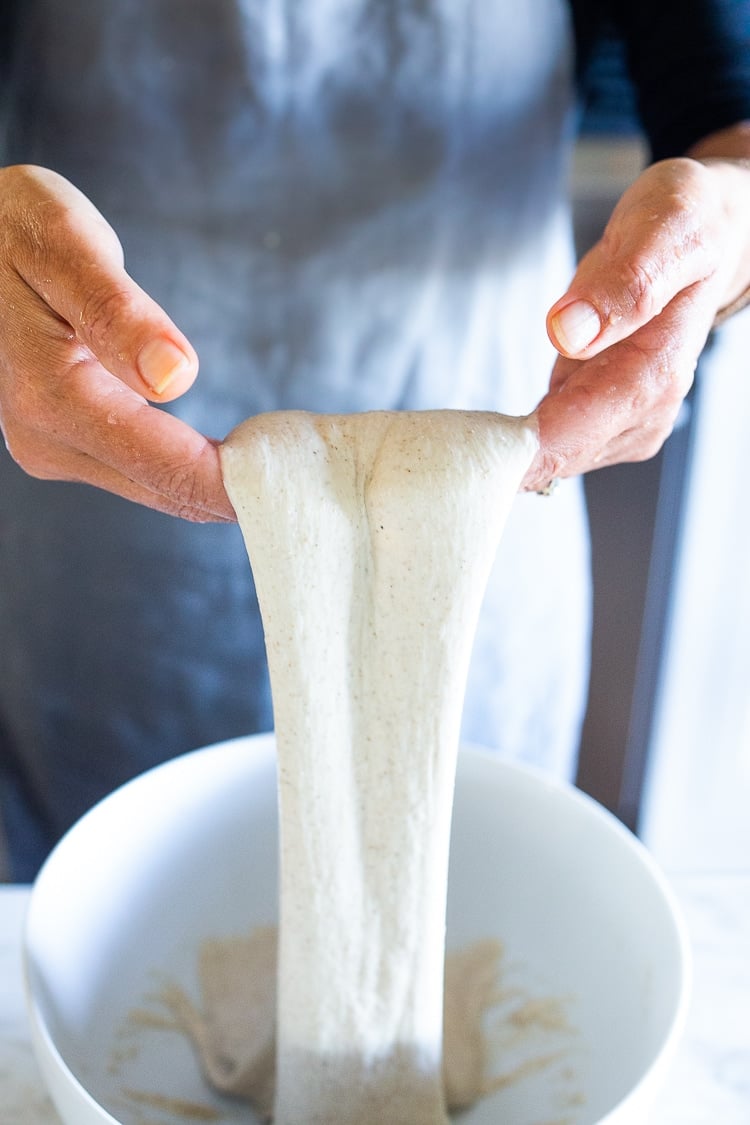
As you see above, after proofing the dough overnight, it will become much looser. The starter has metabolized the flour overnight. This can be tricky to handle. BUT, using wet hands and learning the 2nd stretch and shape technique in the second video above, will make the wet dough much easier to handle. Trust me here. 🙂
After the second set, lift the dough into the parchment-lined bowl. Many sourdough recipes call for placing the dough on a work surface to shape it, creating surface tension- we are skipping this step and using this stretch and shape technique instead- just to keep it simple.
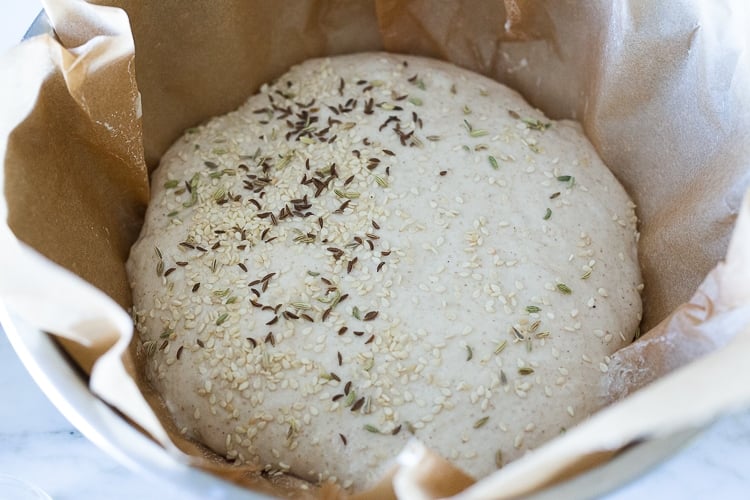
Sprinkle the top of the dough with seeds and dust with flour or rice flour (which makes it easier to score)especially if using the banneton, get those sides sprinkled well- so it flips out without catching!
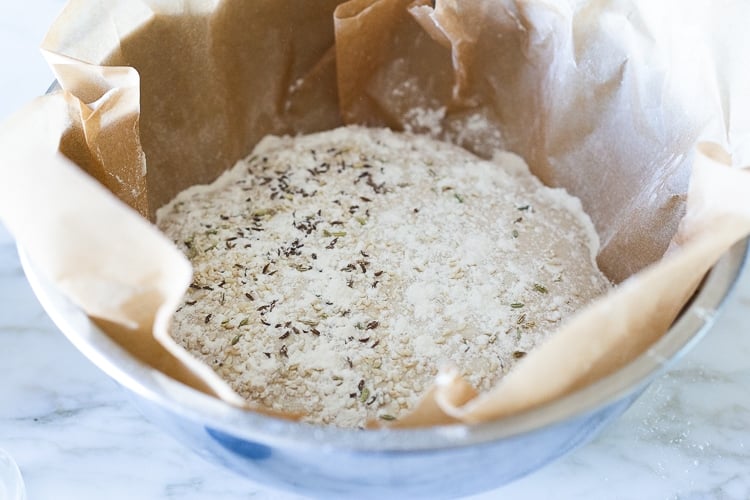
STEP 8: Second “RISE” and PREHEAT OVEN
Place the dough in the fridge for one hour (or up to 3 hours) while you heat up the oven to 500F with your Dutch oven inside (please see notes) for 60 minutes. Chilling the dough will make it easier to score and give it a little more “oven spring”. It is not intended to rise here.
STEP 9: SCORE & BAKE the sourdough
Score: Grease your blade or lame, and score the dough swiftly and deeply, at a 45-degree angle, 3/4 inch deep. Score where you want the dough to puff up. You can do one simple slash, a crescent, or a crisscross, or feel free to add other designs. (Just google sourdough scoring designs and be mesmerized for hours!) Oiling the knife helps. The lame really does make this 100 times easier!
Carefully take out the dutch oven from the oven and close the oven door. Remove the lid. Gently lift your dough holding onto the parchment corners, and lift it into the dutch oven, and quickly cover.
Bake: Place in the middle of the oven for 18-22 mins. Remove the lid; it should be nicely puffed, lightly golden, and around 200F. This is your goal. Continue baking 10- 15 minutes until deeply golden and internal temp reaches 208F. Please try to get your loaves crusty and deeply golden. Let them go a bit longer than you might think. 🙂
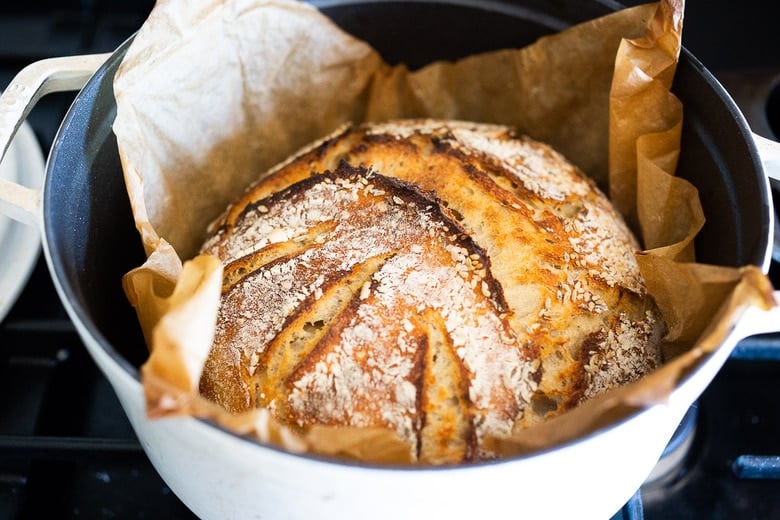
Pull it out, place it on a rack and let it cool before cutting. The HARDEST part! 😂
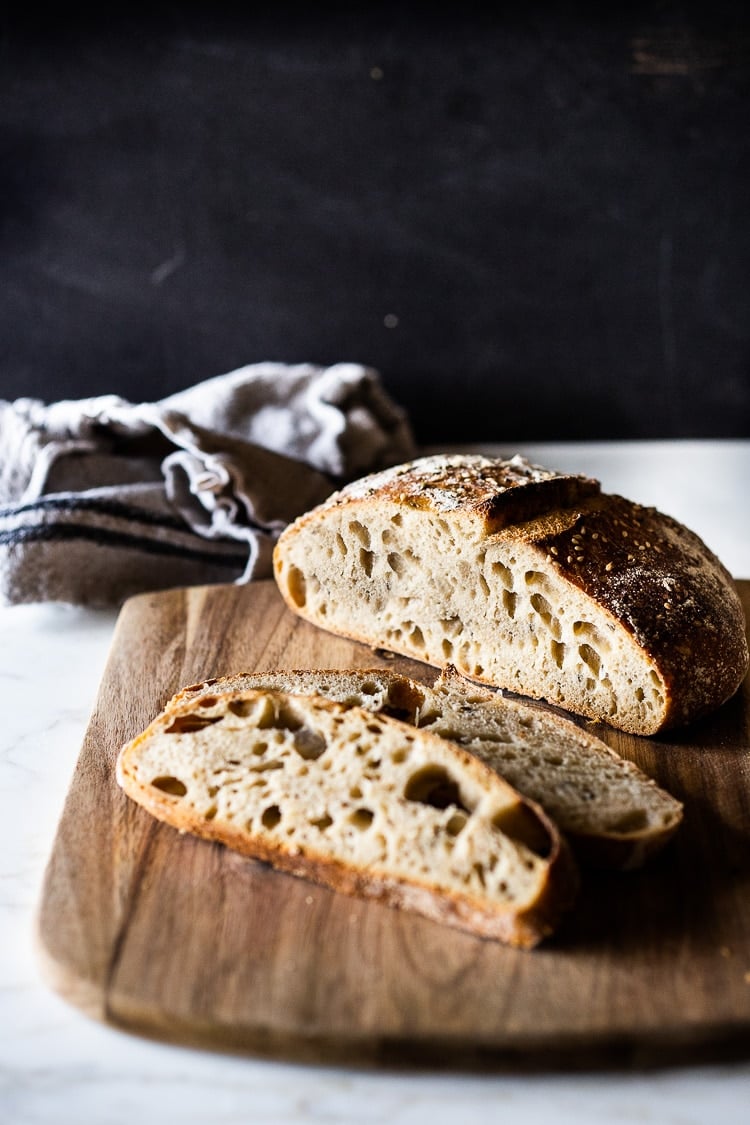
It will smell heavenly and you will feel proud. Bask in it! It truly is an accomplishment!!
Sylvia’s Expert Tips
- STARTER: Using your starter slightly after its peak will ensure your bread rises sufficiently. Make sure your starter is healthy, strong and “hungry”, and doubles in size 6 hours after feeding. If you like a more “sour” taste, use an un-fed starter that has been stored in the fridge 5-6 days- and use without feeding it first.
- FLOUR: For your very first loaf, I highly suggest just using Organic White Bread Flour and be sure to weigh it. ***Please “zero out” the weight of the bowl. Weigh the flour without salt, seeds, or other additions. Try substituting a 1/2 cup of flour for another kind. For example, 3 1/2 cups white bread flour, plus 1/2 cup rye or whole wheat. If you add more whole grain than that, your loaf will be quite heavy and dense. I really don’t want this for your first loaf and neither do you. You want it to be amazing so you feel inspired to make it again and again. So be patient. After several practice loaves- yes, fiddle with other flours as much as you like!
- WATER: (Hydration) A wet dough will produce a lot of beautiful air pockets but it is much harder to work with, in the beginning. A dryer dough will yield a slightly denser, less airy loaf but will be easier to work with, in the beginning. This one falls towards the later – at 75% hydration- but you can easily adjust this down the road, as you practice, by adding a little more water or less flour in the initial mixing stage. To calculate the hydration level, you divide the water grams by the flour grams. In this case 385 divided by 520 = .75 or 75% hydration. As you get more comfortable, try for 80%-85% hydration, adding in a few extra folds at both stages.
- ADDITIONS: If you want to start adding things to your bread- nuts, olives, cheese, dried fruit, roasted garlic, etc., I recommend folding these in after it rises overnight. Use this recipe for Rosemary Olive Sourdough Bread as a guide.
- BAKING: Always preheat the oven. If you have convection, use it! Use a 4-6 quart dutch oven: Make sure your Dutch oven can handle a 500F oven. Plastic handles will melt. If not, 475F or 450F will suffice, but you’ll need to bake it longer (25-30-ish minutes) before removing the lid (remember the goal is for bread to be 200F when the lid comes off) then bake for 10-15 more minutes uncovered. Always check bread with a thermometer.
- TAKE NOTES: Note your rising times and baking times and adjust accordingly the next time. All kitchen environments and oven temps are different.
Trouble Shooting Sourdough Bread
- OVER-PROOFED: If your dough is flat, overly runny, loose, or breaks when shaping you have probably over-proofed it Note the rising time and temperature in your home, and shorten this next time. It’s easy to overproof in warm climates. You can tell if it is over-proofed, if the dough is flat and runny with lots of air bubbles at the top (it has probably peaked already and now is going down) or doesn’t spring back when you do the poke test, or breaks when stretched. Even still you could try to bake it (might as well at this point, right? ) Do the 2nd video stretch and folds-it will be runny, so manage as best you can and put it in the fridge to firm it up a bit before baking.) Turn “imperfect loaves” into croutons, bread crumbs, etc.
- UNDER-PROOFED: If your bread is gummy and dense with little rise, this can mean your bread didn’t proof (rise) long enough in the initial overnight rise or your sourdough starter wasn’t “strong/active” enough. Double-check that your starter is doubling in size within 6-8 hours of feeding (see our troubleshooting section in this Sourdough Starter Post. Note the time and temp in your house, and it let rise longer next time. This can happen if you are used to baking in summer and now shifting into winter. The kitchen is colder, so the dough will require longer proofing. You can tell when you do your stretching and shaping. If it is not stretching like the video it probably has not proofed long enough. Just let it go longer -or leave it out to rise in the bowl after shaping (instead of putting it in the fridge) for an hour or two. Gummy bread can be turned into croutons.
- NO or LITTLE RISE: This is most likely an issue with your sourdough starter- please read through this troubleshooting section. Double-check that your starter is doubling in size within 6-8 hours of being fed. Also, sourdough may not puff up as much as yeasted dough. It may only rise by 1 1/2 or 1 3/4 (not actually doubling in size). Just look for that slight dome and jiggly belly feel, and do the “poke test”. It should feel like a full belly with a slight dome and a bouncy spring to the touch. Check the temp with a thermometer. If it is under 70 F it might just take a little longer to proof. If it is warmer, it may have peaked without you noticing and now is going down. If you want to be very precise about the rise height and time, you can measure the overnight rise in a 2-quart measuring container with clear sides the first few times to get an idea of rise level and timing. It should rise by 1.5 or 1.75, so not quite double. I found this practice to be very helpful.
- NO FLAVOR: Did you forget the salt? This is the most common issue if bread is bland. Salt is imperative.
- TOO SOUR: The “hungrier” the starter, the more sour the bread. Feed the starter 8-10 hours before baking for less sour loaves.
- NOT SOUR ENOUGH: Use an unfed starter. The longer it’s unfed ( but within the 7 days) the more sour it will be.
- OVERLY WET OR DRY DOUGH: Many people accidentally mismeasure the flour because they forget to “zero out” the weight of the bowl or measuring cup on the scale! Check your weight (without seeds, salt or any additions) only flour.
- WEIRD FLAVOR OR SWEET SCENT: Your starter may have been contaminated with unpleasant bacteria. Bread should taste/smell heavenly, earthy and “bready” after coming out of the oven. Like the best smell ever. 🙂
- BURNED BOTTOM Perhaps lower heat to 475F with a slightly longer bake. Also, try placing a sheet pan under the Dutch oven (but don’t preheat the sheet pan). Or add a layer of cornmeal below the parchment. Burnt bottoms seem to happen mostly in electric ovens.
Sourdough FAQS
Digestibility: Sourdough bread is more easily digestible than bread made with commercial yeast, due to the natural fermentation process. This can be beneficial for people with gluten sensitivities.
Higher nutrient content: Sourdough bread, made with organic, non-GMO flour is higher in nutrients and lower in glyphosates.
Bread made with sourdough starter has so much more flavor and complexity than yeasted bread. It is also much easier to digest because it is fermented. Many people who are gluten-sensitive do much better with bread made from sourdough starter.
If your bread is gummy or overly moist after baking, most likely, the dough was underproofed, or your starter is too young or insufficiently active. Try proofing longer, and double-check your starter is healthy and active and doubles after 6 hours of feeding.
Underproofing the dough can cause bread to be dense- by not allowing enough time for the carbon dioxide to develop and create the bubbles in the dough that create the airy texture. An inactive starter can also be the culprit.
Most likely, the sourdough has over-proofed and has collapsed, creating a flat hard loaf. It is still edible, but not as light and airy as it should be.
Besides the reasons above (underproofing the dough and an inactive starter) sourdough can be overly dense if you use too much whole-grain flour, or not enough water.
Most likely, the salt was left out or mismeasured.
Active and healthy sourdough starter is the secret to perfect sourdough bread! Care and proper feeding of your starter will ensure your sourdough loaves are beautiful, flavorful, light, and airy. A Sourdough Starter that doubles in size within 6 hours of feeding is the best sign that the starter is healthy and active.
Practice Makes Perfect!
Baking sourdough is such a satisfying hobby. Making your first “good” loaf is the BEST feeling EVER! Know that every time you bake, your bread will improve as long as your starter is healthy and active.
I suggest that you make the exact same loaf, repeatedly, a few times to get it down before changing any variables. Take notes each time. Consider this first month of baking as “practicing”. The most challenging thing is getting to know your environment, kitchen temperature, oven temperature, and timing, and getting your starter healthy.
So just be patient, keep trying, and don’t give up. I promise you will get it -read the reviews for inspiration!
Enjoy the sourdough process ~xo
More sourdough recipes you'll love!
Sourdough BreaD Video (start-to-finish)
This 16-minute, step-by-step video will show you how to make sourdough bread from start to finish, with me walking you through it personally.
Don’t see the video? Allow 15-20 seconds to load it right here. If still not showing, check that your ad blocker is off, refresh the page, or try a different browser.
***Scroll down to the recipe card for clear, detailed instructions.
Print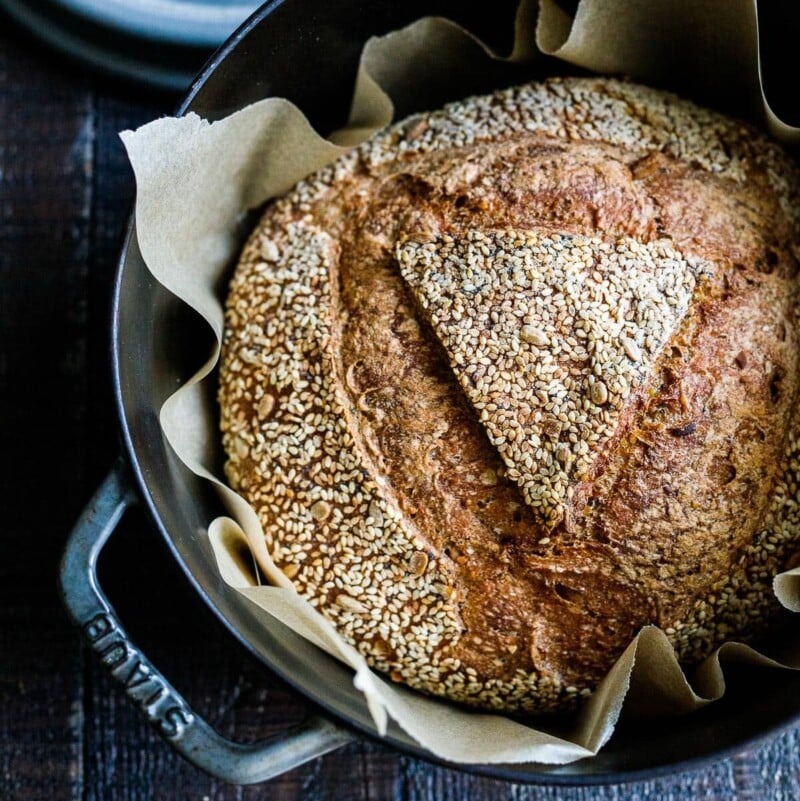
Sourdough Bread Recipe
- Prep Time: 13 hours
- Cook Time: 35 mins
- Total Time: 13 hours 35 minutes
- Yield: 1 loaf 1x
- Category: baked
- Method: bread
- Cuisine: American
- Diet: Vegan
Description
An easy Sourdough Bread recipe that rises overnight and bakes in the morning. A simple flexible recipe made with sourdough starter, that can be adapted to your needs. View the 3 instructional videos above for more details. If you don’t see the videos, make sure your ad blocker is off.
Ingredients
- 4 cups organic white bread flour, spooned and leveled (520 grams total flour) -please don’t include the bowl’s weight. I highly recommend weighing the flour for the first few loaves. (See notes for adding other types of flour.)
- 2 teaspoons fine sea salt (12 grams)
- 1 7/8 cups water (385 grams)
- 90 grams homemade sourdough starter or store-bought starter (1/3 cup) fed 8-12 hours earlier, using it slightly after peaking (For a more “sour” taste, use an unfed starter, 4–6 days after feeding if refrigerated- see notes.)
Optional additions:
- rice flour (my favorite for dusting a banneton).
- Seeds for flavoring: fennel seeds, chia seeds, flax seeds, caraway seeds, sesame seeds, poppy seeds, dill seeds, celery seeds, nigella seeds, etc. (optional, but tasty) My favorite is 1 teaspoon fennel seeds, 1/2 teaspoon caraway and 1 tablespoon chia seeds
- Substitute 1/2 cup rye flour, spelt flour or whole wheat flour or other whole-grain flour for 1/2 cup of the white bread flour if you like- resisting the temptation to add more for your first few loaves. (62 grams max).
- Add herbs (fresh or dried- rosemary, thyme, sage, etc).
- Add nuts, olives, garlic, dried fruit or cheese (please see this Rosemary Olive Sourdough Bread Post, for more “how-to” instructions).
Instructions
- 8 am. Twelve hours before mixing your dough, feed your sourdough starter, leaving it out on the counter making sure it doubles in size within 6 hours. (See notes for extra sour). OR, if you keep your starter in the fridge and fed it in the last 7 days- it is OK to use it straight from the jar, cold, without feeding. Best to use starter after it peaks, when it is “hungry”.
- 8:00 pm PLEASE use a kitchen scale if this is your first loaf. Weigh the flour in a medium bowl (***zero-ing out the weight of the bowl). Then add salt, spices, seeds. Mix starter and water in a small bowl until cloudy and well mixed. Pour the starter-water into flour incorporating all the flour using a fork or wood spoon. It should be a thick, shaggy, heavy, sticky dough. See video. Mix for about 1-2 minutes using the wood spoon- it will be hard to mix. Don’t worry about tidy dough here, just get the flour all mixed in and cover with a wet kitchen towel and let rest 15 minutes. It will loosen up as it rests. (Alternatively, mix starter and water in the bowl first, then add the salt and flour-like in my 3rd video- either way works.)
- 8:20 pm: Do the first set of stretches and folds. (See the 1st video in post) With one wet hand (put a bowl of water next to you) pull the dough from one side and stretch it upward, then fold it up and over to the center of the dough. Quarter turn the bowl and repeat, stretching up and folding it over the middle, repeat for about 30 seconds or until the dough gets firm and resists. This helps strengthen the gluten. Cover, rest, and repeat the process 15 minutes later. With wet fingers, stretch up and fold over, turning, repeating, for 30 seconds until the dough gets firm and resists. Then turn the dough over in the bowl. Yes, you could do this a couple more times if you would like to build the gluten, but not imperative. 🙂
- 8:35 pm Proof overnight, at room temp. Cover the bowl with plastic wrap, wax wrap, or a damp kitchen towel (to keep the moisture in) and place it on your kitchen counter for 8-12 hours. (see notes on temperature) 68-70F is the ideal temp. (If it is warmer, check at 6-8 hours. If it is very cold, it may take up to 18 hours in winter.)
- 6-8 AM Check the dough in the morning. The dough should have expanded, with a slight springy dome to the top. It won’t necessarily double in size ( maybe 1.5 -1.75 times bigger) but will have expanded. Do the POKE TEST: With a floured finger, poke into the dough. If it indents easily and mostly springs back to its original shape, it has probably risen enough. If it feels firm or very hard to indent, let it rise longer. If it feels loose, runny, or indents too easily or doesn’t spring back, it is most likely over-proofed (bake it anyways).
- Line a high-sided bowl with parchment. This brand of parchment does not stick to the bread- but if you are unsure about yours, spray oil your parchment lightly before putting the dough in it. (If you are a seasoned bread baker, you do not actually need parchment -this is only for easier transport only, bread will not stick to the inside of a dutch oven.) I like using a high-sided medium-sized bowl versus a flat or shallow bowl to help shore up the sides. You can also use a rice-floured Banneton (bread proofing basket) if you have one.
- 2nd Set of STRETCH and SHAPE : (Watch 2nd video -Stretch and Shape video). Loosen the dough from the all edges of a bowl with using your wet fingers, a wet spatula or wet plastic dough scraper, sliding down the sides of the bowl. With both wet hands, carefully pull the dough straight up, in the middle and lift it, stretching straight up in the air- about 1-2 feet (see photo) and place it back down, gently folding it on top of itself. In this first stretch, the dough may feel quite loose and runny. This is OK. It should firm up as it stretches and folds. (Note: If your dough breaks here, it is probably over-proofed, bake it anyways. If your dough won’t stretch like the photo and feels too tight or firm, it needs to proof longer). After the first stretch, give the bowl a quarter turn, wait 30-60 seconds, wet your hands again and stretch it up high again, folding over itself in the bowl. Wait 30-60 seconds. (You could repeat this one more time, 15 minutes later). Then, the third time you lift and stretch, you will lift it all the way into your parchment-lined bowl, folding over itself like you’ve been doing. (Alternatively, lift it into your floured proofing basket seam side up. ( If seam up, pinch the seam closed). Sprinkle top with seeds and flour (get the sides too) gently rubbing it to even coat –and add seeds if you like. If using a banneton, sprinkle the seeds in the banneton before adding the dough.
- FINAL RISE and PREHEAT OVEN: Place the bowl in the refrigerator for one hour uncovered which will firm up the bread, and make scoring easier and help boost “oven spring”. It won’t rise in the fridge. (You could also keep it in the fridge for 3-4 hours if you want to bake later.) Preheat the oven (for 1 FULL hour) to 500F with your dutch oven inside and lid on (see notes). If you have convection- use it. You can also bake the bread at 45oF or 475F. You want your oven as hot so don’t skimp on the preheat. I usually preheat for 1 full hour.
- SCORE & BAKE When ready to bake, place dough by the stove. Pull out the dutch oven, close the oven, remove lid. Score the bread in the bowl, using a very sharp knife, lame, razor blade, (or try scissors dipped in cold water), score the dough swiftly and deeply, at a 45-degree angle, 3/4- 1-inch deep. One deep slash is just fine. Or criss-cross, or crescent shape. (Or feel free to add other designs, for ideas -google “scoring bread”). You want to score where you want the dough to puff out from. You can also cut with wet kitchen scissors. Carefully lift the parchment by the corners and place both bread and parchment directly into the dutch oven. Cover quickly. It is OK if parchment peaks out. You want to score and transfer as quickly as possible. (Alternately, if using a proofing basket, cover the basket with parchment, carefully flip the dough into the parchment in the palm of your hand and then center the parchment and dough into your dutch oven, then score).
- BAKE. Place dutch oven in the middle of the 500F oven for 20 mins with convection on, 25 minutes w/no convection (or 28 minutes at 450F). Remove lid. It should be puffed and just lightly golden and internal temp close to 200F (if not, put lid back on for a few more minutes). Lower heat to 450 F, continue baking 10-15 minutes until deeply golden and internal temp reaches 204- 208F. No pale loaves please, let them get golden! (For a less “crusty” loaf, increase covered baking time, lower uncovered baking time. You can play with this for desired results.)
- COOL: It will smell heavenly. Remove from the dutch oven, let it cool 1 hour on a rack or tilted up on its side, before slicing so you don’t let the steam out and don’t smash it- be patient. This is the hardest part. 😉. Take a picture! Feel proud. You did it!
- SERVE: This type of bread is always BEST, served toasted! Then lather it with butter, ghee or olive oil. Add mashed avocado and salted tomatoes, almond butter, honey or jam. A piece of toast can turn into a great meal. See this Mushroom Toast!
- STORE: Store the bread wrapped in a kitchen towel for the first day or two to keep the crust nice and crispy, then move it to a zip lock bag to keep it moist for longer. Bread can also be sliced and frozen. Make sourdough croutons with leftover bread- great in salads and soups!
Notes
Sourdough starter : Using your starter after its peak will ensure your bread rises sufficiently. Make sure your starter is healthy, hungry, and strong, able to double in size 4-8 hours after feeding. If you store your starter in the fridge and last fed it over a week ago, make sure to feed the morning before making bread. If it has only been 3-7 days since last feeding (and you keep it in the fridge), it is OK to make bread without feeding. Use a 1/3 cup starter for your bread dough and place the remaining back in the fridge and feed a week after the last feeding. BUT if it has been a week after your last feeding, pull it out of the fridge, discard (or save for pancakes, waffles, or give away) all but 1/2 cup. Feed it. Let it metabolize the flour 4-8 hours before mixing up the bread dough. Use a 1/3 cup of starter (90 grams) for the bread, place the remaining back in the fridge, and feed in a week. For a more “sour” flavor, use starter that has been in the fridge 4-6 days. Do not feed before using it. The sourdough starter is the sourest the longer it goes without feeding.
Dutch Oven or Bread Baker: Make sure your dutch oven or bread baker can handle a 500F oven. If not, 450F will suffice, and bake 25 minutes before removing the lid. Aim for an internal bread temp of 200F when removing lid- before baking it uncovered. Take notes and adjust the next time!
NO DUTCH OVEN? If you don’t have a dutch oven, you can try baking your bread on a sheet pan, covered with a large metal bowl or pyrex bowl to keep the steam in. It will yield a flatter loaf but it does work. Bake 25-30 minutes covered, remove the bowl, bake until golden 10-15 more minutes until golden, and be sure to check internal temp with a thermometer. It may take a few practices tries to perfect this.
Smaller Loaves: If you would like to create two smaller loaves bake each at 450F for 18 minutes (or until internal temp is 200F) uncover, lower heat to 425F and bake until golden and internal temp is 204-208F. You may have to fiddle with this timing.
LOAF PAN: Yes you can bake this in a loaf pan. Shape and place it in an oiled loaf pan ( or line with parchment) for the last hour in the fridge, while oven preheats. Bake uncovered at 450 for 15 minutes, lower heat to 425 and bake another 25-ish minutes or until internal temp reaches 204-208F. You may need to play with this according to your oven. Place on middle or lower rack.
PRACTICE: As you practice making your loaves (yes, it is a fun practice) you’ll get a feel for the dough and you’ll begin to notices how changes in seasons (changes in temperature) affect the loaves and their proofing time. I suggest making the exact same loaf repeatedly several times. Warmer temps will call for shorter proofing, cooler temps, longer proofing. You can also change the proofing time by adjusting the sourdough starter amount. For a faster rise, you can add a little more starter, for example, a 1/2 or 2/3 cup. For a longer cooler rise, say in the fridge for 36-48 hours, you can reduce the starter amount to 1/4 cup or even 3 tablespoons. You can play with ratios to get the proofing time just how you want it. Take notes! You can also adjust the hydration for an airier loaf, either reducing flour or increasing water. So many variables!!! *Remember your starter and your dough are actual living “creatures” that are affected by your particular environment. The most important advice I can give you is to pay close attention to your particular “creature”, observe it carefully, and look for signs- it is communicating with you. Pay attention. 🙂 Work with it, not against it. Be patient, respond thoughtfully.
Perfecting bread is a lifelong process, and I’m still learning too. 😉
Nutrition
- Serving Size: 1 slice ( 1/12 of a loaf)
- Calories: 154
- Sugar: 0.2 g
- Sodium: 582.3 mg
- Fat: 1.1 g
- Saturated Fat: 0.2 g
- Carbohydrates: 32.7 g
- Fiber: 4.9 g
- Protein: 6 g
- Cholesterol: 0 mg
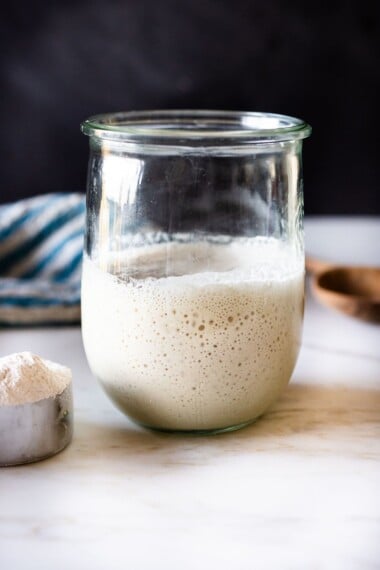
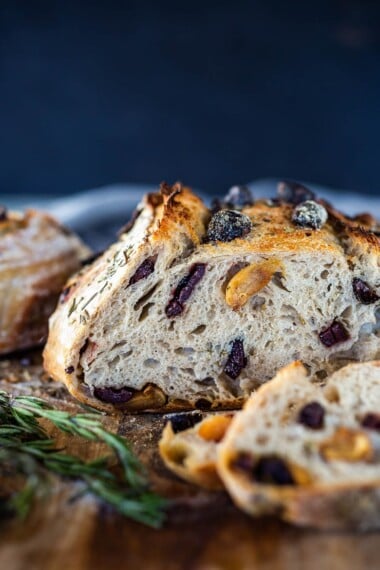




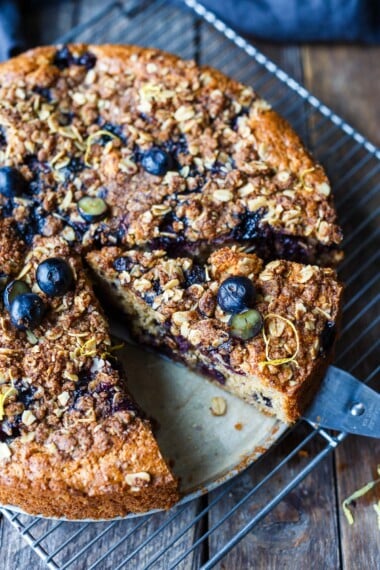




Hi
I love this recipe. My loafs turn out perfect.
I was wondering if I can double the recipe to make a bigger loaf ?
Does it work?
Great question and I think it would work fine but… would you bake it as one giant loaf or two loaves? If one giant loaf, baking time would increase but I’m not sure by how much. You’d have to play with it.
Great straightforward recipe! I made my first loaf, and other than I don’t think I let it proof quite enough in the refrigerator overnight (I missed the note at the bottom with how long it should be in there)- it came out pretty good! Slightly doughy inside, but I am assuming it was a proofing issue. I like a real sour tasting sourdough, so wanted to try and increase how sour it was. Live and learn I guess, on to the next loaf!
One question- if I put my starter in the refrigerator to hold it- do I feed it before using it again (so as not to deplete the supply?) I think I read you can use it ‘hungry’ straight from the fridge, but I’ve read so much about sourdough now I just managed to confuse myself!
Hi Nina- you can use it straight from the fridge up to 6 days after feeding.
Great thank you! I tried another loaf with hungry refrigerated starter, but suspect it may have over-proofed on my counter as it was quite puffed up by the time I was able to get to it. (I have a 3 year old and an 8 week old puppy.) This one definitely smelled more sour but I haven’t cut into it yet to check out the inside. When I try and do the proof test, even when I four my finger, the dough always stick to my finger so I have no idea if it is ready or not. Any tips? Should I try a watered finger instead?
Also- do you know how to make cuban bread? So far I have tried twice and it didn’t come out. Your directions and videos are so helpful it would be great if you had a set for Cuban bread!
I haven’t tried Cuban bread! Great idea though. You just need a little more flour, maybe put it on the dough itself.
worked perfectly! thanks for all the detailed tips and tricks too
Detailed instructions were great. After a couple of flops, finally produced bread I could be proud of.
Very nice recipe! I made it several times with 100% success rate and we love the result. The only problem is that we eat it too quickly and I have to bake again… Does anyone have experience with scaling the recipe up by 1.5 or 2? How would that affect the proofing time and the baking time?
Please, has anyone tried to make a bigger loaf?
The most delicious sourdough bread I have ever made! This will be my go-to recipe. My first loaf was fantastic, my family raved!
Yay Kristine! congrats!
I love this recipe!! I prefer my sourdough on the more sour side and am really intrigued by your suggestion to use unfed starter straight from the fridge to achieve a more sour taste. Do you have tips on how to make sure the starter is strong enough if it’s been in the fridge??
Just make sure it is strong to begin with. 🙂 Use 3-5 days after feeding.
Thank you for this amazing and so simple recipe that gave my sourdough passion back. The best result ever. Love that moderate sour taste and the open crumbs.
Thanks very much for this recipe. I’ve made a starter using your recipe and used that to make 5 loaves now. Every one has got better each time. However, I am still struggling with the scoring part. The dough just seems a bit wet and no matter which (oiled) knife I seem to use, it just kind of sticks to the dough. Are there any other tips on scoring a no knead dough?
Thanks
Hi Darryl- flouring the top helps, using the sharpest knife possible with a firm assertive slash and maybe getting a lame.
AMAZING, took 2 weeks to grow my starter thanks to the cold unpredictable weather here in New Zealand but 100% worth the persistence . I’m sitting here eating my first slice, it is absolute perfection. I can’t believe how successful my first attempt is!!
Yay!!! the BEST feeling in the world. Congrats to you!!! I’m proud of you- two weeks is a lot of patience. But if you care for your starter it will last a lifetime.
I tried the starter and the bread. It turned perfect . The bread was amazing. Your blog is very accurate and precise and full of generous tips. Thank you so much. I am
In PAris. Nadine Camel-Toueg
Thanks so much Nadine!
Hi! I’ve made this twice so far, and the family loves it! Thank you so much for posting it! I was wondering- is there a way to form it into more of a sandwich loaf?
Great question and I havent tried that! You could probably reduce the recipe by 3/4 and put it in a loaf pan, set it on a sheet pan, covered with a metal bowl, lowering heat a bit. Totally guessing here. 🙂
Hi,
I’ve tried this recipe once and am trying it again for the second time. But, both times my dough has been very wet and therefore did not hold its shape. I measured out the flour accurately (as well as the other ingredients) but still resulted in a very wet dough.
When trying to do the second set of stretch and fold, my dough tore in the process and was difficult to transfer to the proofing basket. It did not hold it’s shape when transferring to the dutch oven. It was a very liquidy dough. I do not think it was overproofed as it was domey and when I poked it, it stayed.
I am not sure what I’m doing incorrectly. If you could please advise, it would be greatly appreciated!
Thank you!
I wonder if you tried doing 2 extra sets of stretch and folds before proofing overnight. To me, it sounds like the gluten didn’t get built up enough if it is tearing. Just a guess. Not absolutely sure here.
Thank you so much for your recipes and pointers. Invaluable! So far, we have loved the berry scones and the pancakes with sourdough discard. Still working out kinks on bread.
I’ve made the no knead bread twice now. The first time it was very heavy and moist. The second time the bread was delicious–I proofed the dough longer, baked at 450 degrees + longer, but the loaf was less than 2 inches high. Both times the dough was very wet and difficult to work with. The 2nd time I stretched and folded more–4 times with slight improvement but still wet.
Do you have any suggestions for managing the wetness of the dough and making the bread rise more? Thank you very much,
Is your starter very active and strong? Doubling within 4-8 hours of feeding?
Starter doubled exuberantly and passed float test, but maybe I did wait little too long to make dough. Will make third batch to see and check in if necessary.
Banana Bread was so fabulous. Thank you, E
Thanks Ellen.
Excellent recipe and instructions! I followed each step and the ratios, by weight, were perfect. I have tried numerous other ones and most are too daunting and this wasn’t at all. The pictures and videos were great and showed what I was unsure of from just reading the instructions. Thank-you!
Very good! Instructions were very helpful (rather than confusing). Resulted in perhaps my best sourdough loaf yet!
Hooray! I love hearing that.
I tried this recipe twice and followed it precisely but my bread didn’t proof overnight:(
It might be your starter? Is it healthy active and doubling after 4-8 hours of feeding?
Thank you so much! I’ve made 5 delicious loaves of sourdough bread following your recipe and schedule. But my question is that the last two loaves I baked, as my dough proofed overnight, it rose so much it was almost overflowing the bowl. Both of those last two loaves were absolutely delicious, lovely crust, perfect crumb, delicious taste and looked perfect. Also, my starter triples with about 4 hours after feeding. Do you think my starter is too powerful? Should I be feeding it less? Thanks so much. I appreciate your directions!
Well, it sounds like you are doing everything right! Both issues are good problems to have.:) What kind of flour are you using- just curious, I may have to get some! What is the temp where you live?
Whew! Thanks for the encouragement. I was getting a little worried that I might be feeding too much or some other thing. The flour I’m using for the bread and starter comes from Central Milling Co. I’ve been using the Organic Artisan Bakers Craft Plus Flour. Since local supermarkets have been out of flour, I searched online and found one of their locations in Petaluma, CA next to where I live in Cotati, CA. I order online and then pickup up at their shop when it’s ready. The company also has locations in Utah, and they ship nationwide, http://www.centralmilling.com. The temp here at this time of year is usually 45-50 during the night and 65-75 during the day, although we’re about to have a big 4-day heat wave! Thanks again for all your instructions, schedule, and videos!
Thanks for sharing Joyce- sounds like a good resource for flour!
Hi! First I want to say thank you for communicating this complicated process in such a clear way! I think I must’ve watched your start to finish video 4 or 5 times through, and it did the trick! Just finished my first loaf and IT.IS.DELICIOUS. so thank you very much for that 😊
I do have one question though – if I use starter right out of the fridge, does it still have to pass the float test? And how long should it have been in the fridge for, unfed, before using it?
Thanks again! You’ve definitely put together amazing starter and sourdough guides that I will recommend to all my friends! 😊😊
Honestly I only do the float test the first time. You can use it unfed, any time up to a week.
I have made the recipe several times now and each time the loaf sticks to the parchment paper or vice versa I guess. It literally bakes into the bread. Should I be flouring the nonstick parchment before I place the dough into it? Also, I have huge and many air pockets. Seems more than I should. Thank You
I hadn’t realized the tweaking. Just caught that floured parchment note.
yes, flour the parchment. Some brands stick- not sure why. Big air pockets may indicate under proofing. Note your rising time, and give it a little longer next time.
We’ve tried several sourdough recipes over the past few months with varying success. Many were quite complicated, requiring many steps over multiple days, and often didn’t even produce loaves that we wanted to keep. In addition to being relatively simple and less time-consuming, this recipe gave us the best result by far of the ones we’ve tried. We used the alternate method with unfed starter to get a stronger sour taste and it was fantastic. We especially loved the crust and the oven spring, which made a loaf that the two of used finished in less than a day. We’re so glad we found this….thanks! P.S. the only downside was that our dutch oven couldn’t handle 500 degrees for an hour, and the lid handle cracked.
Sorry about your dutch oven. but happy you like the bread. 🙂
I decided to do two recipes. One which had many more steps and this simpler no knead recipe.
This one was definitely the winner. Not only was it beautiful but it was tastier 😋! Highly recommend.
Ps. : really cool the bread, I cooled it for 2 hours and I still think I should have waited another hour before slicing.
Thanks so much!
My first attempt was mostly a success, but it’s a bit chewy/gummy inside despite getting up to temp and didnt quite brown/crisp on the outside the way it should. I’ve never baked really anything except cookies. Any thoughts on where I went wrong?
It sounds like it didn’t proof long enough. Were there big holes?
Yes, lots of wholes, a few quite big
Ok, I think it may need to rise longer next time. Note the time, and add an hour or two?
Love this recipe so much! It’s the only sourdough recipe that’s ever worked for me to actually produce a light and airy loaf. One question though, how do you get the scoring to keep its shape? I’ve followed the recipe to the letter, refrigerating before putting in the hot Dutch oven, but I still can’t seem to get the tacky dough to keep the score marks. The best I can do is one think line down the middle which does allow for some oven spring, but I’d love to be able to make the cross cross or x shape patterns too. I’m using an oiled sharp paring knife and making 3/4inch deep marks as specified.
I think using the Lame (bread blade) works the best. Do you flour the top of the dough? That helps too.
Thanks, Sylvie. Yes, I’ve floured the top of the bread. I’ll try a bread lame though. I don’t have one! Thanks for the tip.
I just want to say thank you. for your slight, but constant updates to this recipe. I have made a loaf of bread using this recipe, each of the last 5 weeks of the Covid-19 lockdown. I’ve noticed your tweaks, from how much water to use and putting the dough in the frig for the last hour to make it easier to score. I appreciate your attention to detail and am having so much fun!
Oh Thanks! Hope they haven’t been too confusing. I get so many questions and comments here so it helps me adjust the recipe itself to make things more clear.